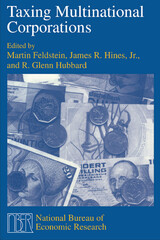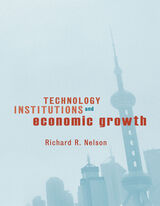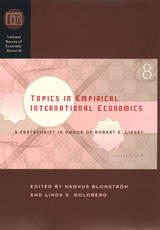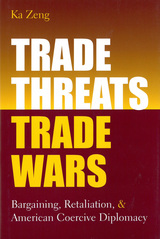163 books about Economics & Trade and 6
start with T
163 books about Economics & Trade and 6
163 books about Economics & Trade
6 start with T start with T
6 start with T start with T

Taxing Multinational Corporations
Edited by Martin Feldstein, James R. Hines Jr., and R. Glenn Hubbard
University of Chicago Press, 1995
In the increasingly global business environment of the 1990s, policymakers and executives of multinational corporations must make informed decisions based on a sound knowledge of U.S. and foreign tax policy. Written for a nontechnical audience, Taxing Multinational Corporations summarizes the up-to-the-minute research on the structure and effects of tax policies collected in The Effects of Taxation on Multinational Corporations. The book covers such practical issues as the impact of tax law on U.S. competitiveness, the volume and location of research and development spending, the extent of foreign direct investment, and the financial practices of multinational companies.
In ten succinct chapters, the book documents the channels through which tax policy in the United States and abroad affects plant and equipment investments, spending on research and development, the cost of debt and equity finance, and dividend repatriations by United States subsidiaries. It also discusses the impact of U.S. firms' outbound foreign investment on domestic and foreign economies. Especially useful to nonspecialists is an appendix that summarizes current United States rules for taxing international income.
In ten succinct chapters, the book documents the channels through which tax policy in the United States and abroad affects plant and equipment investments, spending on research and development, the cost of debt and equity finance, and dividend repatriations by United States subsidiaries. It also discusses the impact of U.S. firms' outbound foreign investment on domestic and foreign economies. Especially useful to nonspecialists is an appendix that summarizes current United States rules for taxing international income.
[more]

Technology, Institutions, and Economic Growth
Richard R. Nelson
Harvard University Press, 2005
This volume mounts a full-blown attack on the standard neo-classical theory of economic growth, which Richard Nelson sees as hopelessly inadequate to explain the phenomenon of economic growth. He presents an alternative theory which highlights that economic growth driven by technological advance involves disequilibrium in a fundamental and continuing way. Nelson also argues that a theory of economic growth driven by technological advance must recognize a range of institutions, such as universities, public laboratories, and government agencies, in addition to business firms and markets. He further argues that growth theories that focus on an aggregate measure of growth, such as GNP per capita, are blind to what is going on beneath the aggregate, where differing rates of advance in different sectors, and the birth and death of industries are an essential part of the growth process. The broad theory of economic growth Nelson presents sees the process as involving the co-evolution of technologies, institutions, and industry structure.
[more]

The Texture of Change
Dress, Self-Fashioning and History in Western Africa, 1700–1850
Jody Benjamin
Ohio University Press, 2024
The Texture of Change examines historical change across a broad region of western Africa—from Saint Louis, Senegal, to Freetown, Sierra Leone—through the development of textile commerce, consumption, and dress. Indigo-dyed and printed cotton, wool, linen, and silk cloths constituted major trade items that linked African producers and consumers to exchange networks that were both regional and global. While much of the historiography of commerce in Africa in the eighteenth century has focused on the Atlantic slave trade and its impact, this study follows the global cloth trade to account for the broad extent and multiple modes of western Africa’s engagement with Europe, Asia, and the Americas. Jody Benjamin analyzes a range of archival, visual, oral, and material sources drawn from three continents to illuminate entanglements between local textile industries and global commerce and between the politics of Islamic reform and encroaching European colonial power. The study highlights the roles of a diverse range of historical actors mentioned only glancingly in core-periphery or Atlantic-centered framings: women indigo dyers, maroon cotton farmers, petty traveling merchants, caravan guides, and African Diaspora settlers. It argues that their combined choices within a set of ecological, political, and economic constraints structured networks connecting the Atlantic and Indian Ocean perimeters.
[more]

Topics in Empirical International Economics
A Festschrift in Honor of Robert E. Lipsey
Edited by Magnus Blomström and Linda S. Goldberg
University of Chicago Press, 2001
In this timely volume emanating from the National Bureau of Economic Research's program in international economics, leading economists address recent developments in three important areas. The first section of the book focuses on international comparisons of output and prices, and includes papers that present new measures of product market integration, new methodology to infer relative factor price changes from quantitative data, and an ongoing capital stock measurement project. The next section features articles on international trade, including such significant issues as deterring child labor exploitation in developing countries, exchange rate regimes, and mapping U. S. comparative advantage across various factors. The book concludes with research on multinational corporations and includes a discussion of the long-debated issue of whether growth of production abroad substitutes for or is complementary to production growth at home. The papers in the volume are dedicated to Robert E. Lipsey, who for more than a half century at the NBER, contributed significantly to the broad field of empirical international economics.
[more]

Trade and Investment Relations among the United States, Canada, and Japan
Edited by Robert M. Stern
University of Chicago Press, 1989
The economic futures of the United States, Canada, and Japan are tightly linked by the extremely powerful trade network these nations share. Yet because of trade and domestic policies aimed at preserving economic and, some argue, cultural integrity, there has at times been considerable friction among the three nations. Much of the recent trade animus of the U.S. has been aimed Japan, the country with the largest trade surplus with the United States. Canada, the largest trade partner of the U.S., maintains fiscal policies which resemble those of Japan, but has not been the focus of similar concern. Since the actions of each nation reverberate throughout the network, a full and accurate understanding of these complex relations will be essential if ongoing trade negotiations, policymaking, and international relations are to be constructive.
The papers in this volume were developed from a conference that addressed the need to discover which structural determinants and policies shape the close economic ties among these nations. Leading experts on trade and macroeconomics from all three countries examine disproportionate saving rates, exchange rate volatility, varying industrial policies and levels of financial innovation, the effects of present tax policies and proposed reforms, and the dynamism of major Pacific nations and the leadership role Japan may play in U.S. relations with that region. Several important conclusions are reached by the contributors. They assert that Japan's trade barriers are relatively low overall and are comparable to those maintained by the United States and Canada, and that divergent fiscal policies have been the major source of macroeconomic imbalances between the United States and other major countries in the 1980s. They also conclude that current trade imbalances may persist for some time. The analyses offered here are likely to prove influential in future policymaking and will be of interest to a wide audience, including academic economists, government officials, and students of theoretical and policy issues of international trade, investment, and finance.
The papers in this volume were developed from a conference that addressed the need to discover which structural determinants and policies shape the close economic ties among these nations. Leading experts on trade and macroeconomics from all three countries examine disproportionate saving rates, exchange rate volatility, varying industrial policies and levels of financial innovation, the effects of present tax policies and proposed reforms, and the dynamism of major Pacific nations and the leadership role Japan may play in U.S. relations with that region. Several important conclusions are reached by the contributors. They assert that Japan's trade barriers are relatively low overall and are comparable to those maintained by the United States and Canada, and that divergent fiscal policies have been the major source of macroeconomic imbalances between the United States and other major countries in the 1980s. They also conclude that current trade imbalances may persist for some time. The analyses offered here are likely to prove influential in future policymaking and will be of interest to a wide audience, including academic economists, government officials, and students of theoretical and policy issues of international trade, investment, and finance.
[more]

Trade Threats, Trade Wars
Bargaining, Retaliation, and American Coercive Diplomacy
Ka Zeng
University of Michigan Press, 2004
This study of American trade policy addresses two puzzles associated with the use of aggressive bargaining tactics to open foreign markets. First, as the country with greater power and resources, why has the United States achieved more success in extracting concessions from some of its trading partners than others? Second, why is it that trade disputes between democratic and authoritarian states do not more frequently spark retaliatory actions than those between democratic pairs?
Ka Zeng finds answers to both of these questions in the domestic repercussions of the structure of trade between the United States and its trading partners, whether the United States has a competitive trade relationship with its trading partner, or whether trade is complementary.
This book offers practical policy prescriptions that promise to be of interest to trade policymakers and students of international trade policy.
Ka Zeng is Assistant Professor of Political Science at the University of Arkansas, Fayetteville.
Ka Zeng finds answers to both of these questions in the domestic repercussions of the structure of trade between the United States and its trading partners, whether the United States has a competitive trade relationship with its trading partner, or whether trade is complementary.
This book offers practical policy prescriptions that promise to be of interest to trade policymakers and students of international trade policy.
Ka Zeng is Assistant Professor of Political Science at the University of Arkansas, Fayetteville.
[more]
READERS
Browse our collection.
PUBLISHERS
See BiblioVault's publisher services.
STUDENT SERVICES
Files for college accessibility offices.
UChicago Accessibility Resources
home | accessibility | search | about | contact us
BiblioVault ® 2001 - 2024
The University of Chicago Press









